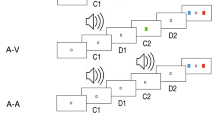Abstract
To clarify the roles of the basal ganglia in time perception, single-unit activity was recorded from both sides of the striatum of a monkey performing a duration discrimination task. In the task, two visual cues were presented successively in different durations (0.2∼1.6 s). Each cue presentation was followed by a 1-s delay period. The subject was instructed to choose a longer presented cue after the second delay period. There were two types of trials for sequence of cue duration, the long-short (LS) trials in which the first cue (C1) was longer than the second cue (C2) and the short-long (SL) trials in which the C1 was shorter than the C2. Striatal neurons phasically responded during the first delay (D1) and second delay (D2) periods. Responses during the D1 period changed depending on C1 duration. Activity of populations of D1-response neurons correlated with C1 duration positively or negatively. Responses during the D2 period differed between the LS and SL trials. Activity of population of D2-response neurons also changed depending on C2 duration. But the dependence on C2 duration was affected by the trial type, that is, whether the C2 was longer or shorter compared to the C1.These findings suggest that striatal neurons could encode cue durations with monotonically changing responses in the D1 period and discrimination results between the two cue durations in the D2 period.


Similar content being viewed by others
References
Buhusi CV, Meck WH (2005) What makes us tick? Functional and neural mechanisms of interval timing. Nat Rev Neurosci 6:755–765
Genovesio A, Tsujimoto S, Wise SP (2006) Neuronal activity related to elapsed time in prefrontal cortex. J Neurophysiol 95:3281–3285
Harrington DL, Haaland KY, Hermanowitz N (1998) Temporal processing in the basal ganglia. Neuropsychology 12:3–12
Ivry RB, Spencer RMC (2004) The neural representation of time. Curr Opin Neurobiol 14:225–232
Kimura M (1986) The role of primate putamen neurons in the association of sensory stimuli with movement. Neurosci Res 3:436–443
Lewis PA, Miall RC (2003) Distinct systems for automatic and cognitively controlled time measurement: evidence from neuroimaging. Curr Opin Neurobiol 13:250–255
Lucchetti C, Bon L (2001) Time-modulated neuronal activity in the premotor cortex of macaque monkeys. Exp Brain Res 141:254–260
Lustig C, Matell MS, Meck WH (2005) Not “just” a coincidence: frontal-striatal interactions in working memory and interval timing. Memory 13:441–448
Malpani C, Rakitin B, Levy R, Meck WH, Deweer B, Dubois B, Gibbon J (1998) Coupled temporal memories in Parkinson’s disease: a dopamine-related dysfunction. J Cogn Neurosci 10:316–331
Matell MS, Meck WH (2004) Cortico-striatal circuits and interval timing: coincidence detection of oscillatory processes. Brain Res Cogn Brain Res 21:139–170
Matell MS, Meck WH, Nocolelis MAL (2003) Interval timing and the encoding of signal duration by ensembles of cortical and striatal neurons. Behav Neurosci 117:760–773
Meck WH, Malapani C (2004) Neuroimaging of interval timing. Cogn Brain Res 21:133–137
Noguchi Y, Kakigi R (2006) Time representations can be made from nontemporal information in the brain: An MEG study. Cereb Cortex 16:1797–1808
Oshio K, Chiba A, Inase M (2006) Delay period activity of monkey prefrontal neurons during duration-discrimination task. Eur J Neurosci 23:2779–2790
Rao SM, Mayer AR, Harrington DL (2001) The evolution of brain activation during temporal processing. Nat Neurosci 4:317–323
Sakurai Y, Takahashi S, Inoue M (2004) Stimulus duration in working memory is represented by neural activity in the monkey prefrontal cortex. Eur J Neurosci 20:1069–1080
Acknowledgments
We thank the technical staff of the Life Science Institute of Kinki University for animal care. Grants This work was supported by grants from the Ministry of Education, Culture, Sports, Science, and Technology of Japan (17021039, 18500314, 19500230), and the Cooperation Research Program of the Primate Research Institute of Kyoto University.
Author information
Authors and Affiliations
Corresponding author
Rights and permissions
About this article
Cite this article
Chiba, A., Oshio, Ki. & Inase, M. Striatal neurons encoded temporal information in duration discrimination task. Exp Brain Res 186, 671–676 (2008). https://doi.org/10.1007/s00221-008-1347-3
Received:
Accepted:
Published:
Issue Date:
DOI: https://doi.org/10.1007/s00221-008-1347-3




